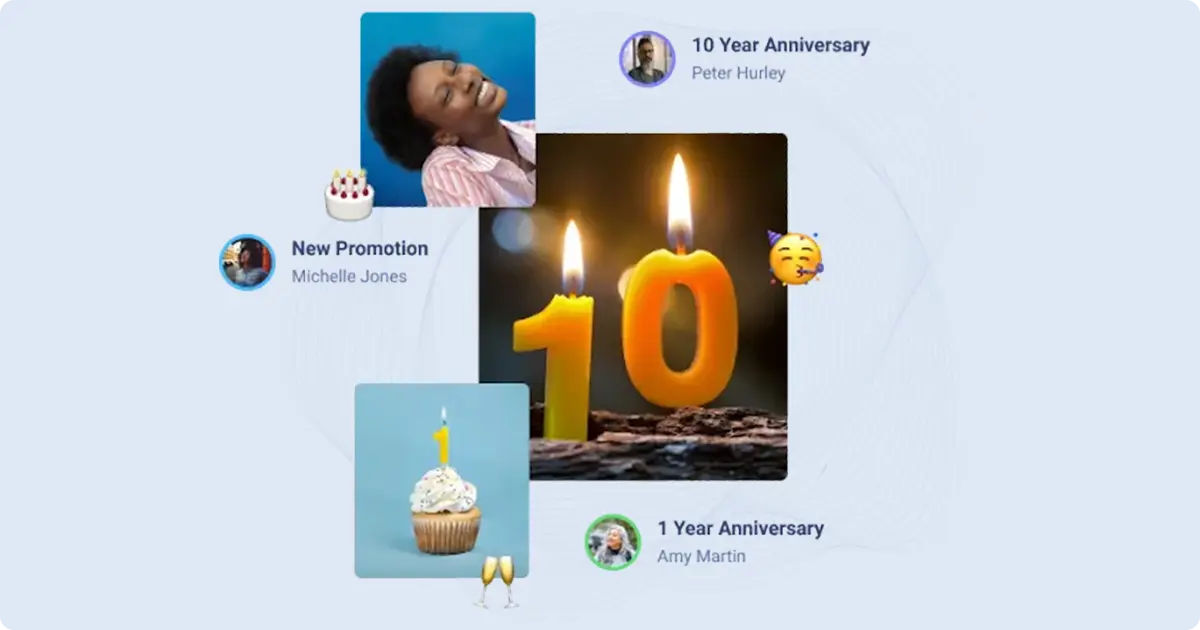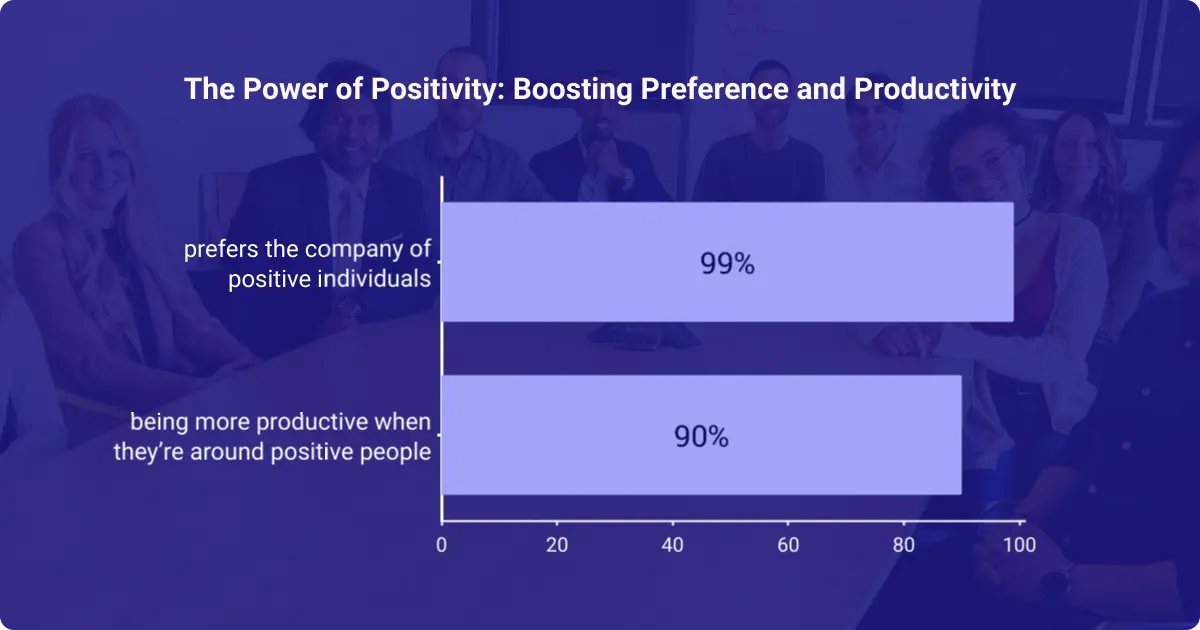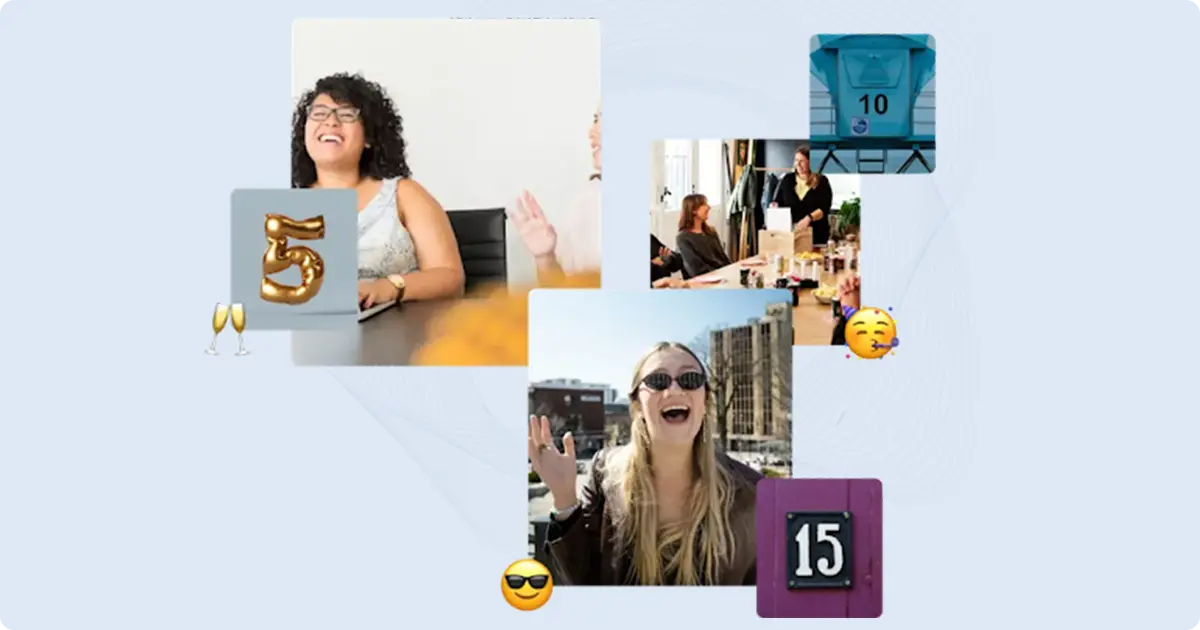Career Milestones: Elevating Employee Engagement and Cultivating a Culture of Celebration

In today's fast-paced work environment, celebrating career milestones is more crucial than ever. It’s a practice that not only recognizes individual achievements but also enhances employee engagement and creates a culture of belonging within your organization.
When you prioritize these moments of recognition, you’re fostering a supportive and productive atmosphere that can significantly impact your company's bottom line.
In this article, we delve into the importance of acknowledging career milestones, explore the positive organizational impacts, and provide actionable insights on how to integrate this practice effectively.
Read on to discover how celebrating career milestones can drive engagement, reduce turnover, and cultivate resilience among your employees.
What are career milestones?

Career milestones are moments in a person’s professional life that represent a significant achievement, anniversary, promotion, or other noteworthy accomplishment at work.
It should recognize the employee’s career success – and look ahead to even greater accomplishments in the years to come.
A true celebration of a career milestone should be a heartfelt invitation to remain connected to the workplace community and continue to succeed.
In other words, a true career milestone program reimagines the work anniversary and transforms every career achievement into an occasion for celebration.
Taking a more comprehensive approach to the employee journey – a service milestone approach – is a chance to highlight and reinforce the connections that make an organization strong.
Experience the power of Service Milestones in your organization.
All career milestones should be more than a simple thanks for past events. It should be a moment of reflection and a recommitment to the future.
Why do career milestones matter?
Celebrating career milestones helps create a culture of celebration – one that is built on a foundation of belonging, social support, and social exchange. Fostering such a culture can have great benefits, including:
- Higher engagement: Social support from coworkers has been shown to significantly impact engagementOpens in a new tab.
- Higher productivity: Employees who feel they are part of a group and are working toward shared goals report increased motivation, positivity, and overall productivity.
- Stronger relationships: Social exchangeOpens in a new tab has benefits that include “reduced conflict, improved performance, enhanced knowledge sharing among peer employees, increased affinity for employees, greater understanding of employee interests and values, and increased trust and tolerance of imbalance in exchange relationships.”
- Higher levels of learning and performance: A culture of psychological safety and inclusion leads to better learning and performance outcomes.
- Reduced stress: When coworkers provide social support, it can ease the impact of a large workload — buffering the impact of burnout.
- Increased resilience and trust: A consistent flow of relational exchanges raises levels of commitment, concern for the reputation of oneself and others, and levels of trust and resilience.
- Better health: When belonging flourishes, it contributes to overall employee wellbeing and performance. Likewise, those who lack a sense of belonging may experience both psychological and biological illness effectsOpens in a new taband even a weakened immune system.
How does a comprehensive approach to service milestones impact the bottom line?
Celebrating your employees’ career journey helps create a culture of positivity and inclusion – the cornerstone of an engaged workforce. And employee engagement has a direct impact on your top and bottom lines – beginning with increased productivity.
As Gallup’s Tom Rath puts it, “99 out of 100 people report they want to be around positive people, and nine out of 10 report being more productive when they’re around positive people.” Higher employee engagement also boosts customer loyalty, sales, and profits.
A Korn Ferry Hay Group study estimates the cost of replacing an employee is between 50% and 150% of salary. For specialist, senior, and executive positions, the cost rises to up to 213% of salary.
Creating a culture of celebration is a proven way to make employees feel they belong. And that, in turn, has a positive impact on employee retention. It not only creates a community atmosphere; it also helps HR professionals differentiate the organization in both retention and recruitment efforts.

What are examples of career milestones?
Career milestones go beyond a one-dimensional, manager-driven approach to the traditional “years of service award.”
They make it simple for all co-workers to recognize and celebrate career achievements and other markers in the employee journey: from onboarding to promotions to transfers – all the way to retirement.
It’s a progressive way to celebrate career home runs because it recognizes all the key events in your employees’ time at the company – not just a once-a-year anniversary.
It creates a deeply impactful community experience and allows the employee’s peers to share in and reflect on the past – while propelling the employee to the next challenge using their professional skills.
Milestones to celebrate include:
First professional job
You never forget your first job – who you worked with, what you learned, how you felt about your boss. Make it even more memorable by recognizing new employees who are coming into their first professional role. It will make them feel supported as they begin their career.
Winning an industry award
Having an employee recognized for their work in the broader industry is a big deal, and it deserves to be celebrated internally, too. Give them a shout-out and encourage them to display their new accolade on their desk for all to see.
Leading a major project
Whether it’s their first project lead or 10th, employees love to be seen for their accomplishments. Reward a job well done by publicly recognizing their success.
Getting a promotion
Promotions are some of the most typical career milestones but that doesn’t mean they should go overlooked. A promotion is always a big deal, whether it’s a step up from their current role or a transition to a new team.
Celebrating a significant anniversary
Another classic milestone, work anniversaries, should always be celebrated. It makes employees feel appreciated every year, and significant ones deserve extra attention. Be ready to celebrate work anniversaries at the five-, 10-, and 15-year marks with a commemorative item and a hearty congratulations.

See also: 43 Happy Work Anniversary Messages, Wishes, and Quotes
What defines a true career milestone approach?
Rather than simply recognizing an annual work anniversary with a perfunctory email, a true career milestone approach commemorates every moment of the employee journey and makes each one an opportunity for community celebration.
How? Many business owners of world-class organizations are turning to a flexible software solution like Service Milestones, part of the Workhuman® platform. Such a solution enables organizations to move to an all-encompassing career milestones concept, with key features such as:
- Open invitations – Whether your employees are remote, on-site, or hybrid, everyone can (and should) be part of career milestone celebrations.
- Crowdsourced approach – Tap into the stories and memories of the people who know your employee the best – colleagues and friends – and make the moment lasting and memorable.
- Personalized experience – Ditch the impersonal approach of formal letters and gift catalogues, and create a unique, human, and personal moment for these milestones worth celebrating.
- Flexible configuration – Organizations are as unique as the employees who work for them. Service Milestones enables companies to customize an innovative approach that celebrates employees and business outcomes.
- Tailored rewards – Celebrate career milestones with rewards that employees will cherish by giving them the power to choose their gift: gift cards, merchandise, or even charity contributions.
- Administrative ease – With Service Milestones, your employees’ peers are automatically invited to contribute – so the task isn’t left solely to managers.
- Highlight values – By tapping into the employee’s past recognition moments, Service Milestones celebrates past achievements and inspires the employee to meet the challenges ahead.
Create a workplace humans will want to join — and a workplace they’ll want to stay.
Find out how with the solutions of the Workhuman Platform.
How to identify career milestones
While we’ve already outlined common career milestones worth celebrating, identifying such moments should be built into your HR program. Why? Because these moments in a career path can make or break an employee’s commitment to their company and make up a core part of your work culture.
Career development maps are helpful for both employees and HR professionals alike.
For employees, it gives them a sense of structure and trajectory for their career path. It creates a step-by-step “plan” to follow as they progress at the company and in their career journey at large.
For HR, it creates a framework to measure employee success and general path. This outline shouldn’t dictate an employee’s growth but rather can serve as a baseline measurement. However the employee deviates from the expected trajectory can indicate all the different ways in which that role can grow and evolve, which gives you valuable insight from a management perspective.
Flexibility and creativity are key in these career development maps. As in life, career milestones are rarely exactly what we expect them to be. Plans and priorities change for both companies and individuals. Rather than sticking to the narrative, it’s important to embrace the fluidity and evolution of careers.
How to achieve career milestones
Building off this career development map, there are a few more steps you can take to ensure you achieve your desired career success.
Creating an action plan
What career milestone do you want to achieve first, and when? Be realistic – a promotion or leadership role is more likely to come before your five-year anniversary, for example. Laying out an action plan gives structure to your dreams and can help you stick to the plan, so to speak.
That said, it’s important to be flexible. You’re bound to hit some bumps along the way, so it’s important to build in room to shift priorities. Being adaptable is far more important than being perfect.
Skill development and continuous learning
Upskilling is one of the best ways to make yourself invaluable. Continuing to hone your skills shows your commitment to your role, while actively seeking out learning opportunities demonstrates your desire to continue growing and evolving.
This kind of training benefits employees and companies alike. It makes employees more competent and agile while strengthening a company’s workforce, making internal promotion even easier.
Conclusion
Celebrating personal achievements at work isn’t just a perk – it’s a must in today’s competitive work landscape. Taking time to recognize these moments worth celebrating shows your employees you value their whole human-ness, that their job is important to their team and the company at large, and that their success is meaningful.
If you have yet to incorporate the ethos of a career milestone into your work culture, it’s not too late. Any time is a good time to start celebrating career achievements.
And with Workhuman’s Service Milestones, it’s easy.
About the author
Maeve Ginsberg
A wellness enthusiast and the mid-day walk’s #1 fan, Maeve champions work-life balance.
Having gone from a corporate job to self employment, Maeve has lived through countless working styles. This evolution forced confrontation of her own limiting beliefs, eventually breeding a completely individualized approach to work and productivity.
As a Senior Copywriter, Maeve often writes on workplace wellbeing and strives to advocate for all workers and leaders to find small yet significant ways to make their work lives healthier and more fulfilling.
Offline, Maeve enjoys testing new cuisines and hanging upside down off walls (also known as bouldering).